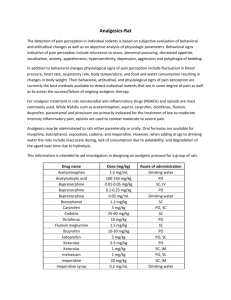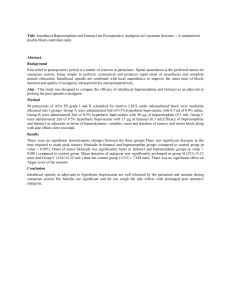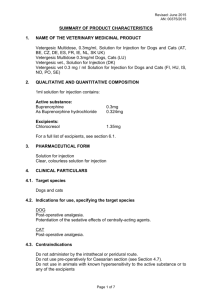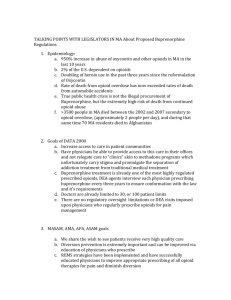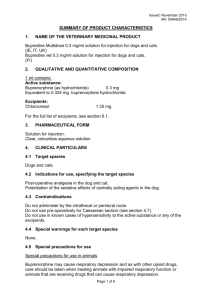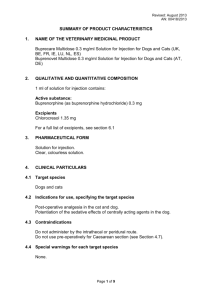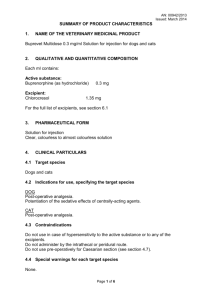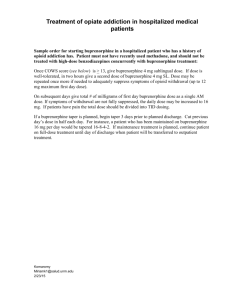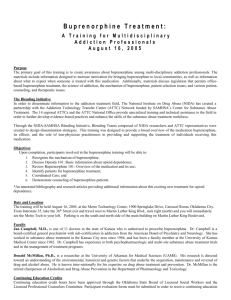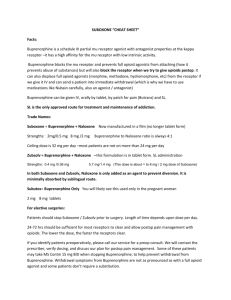VETERGESIC® - Veterinary Medicines Directorate
advertisement
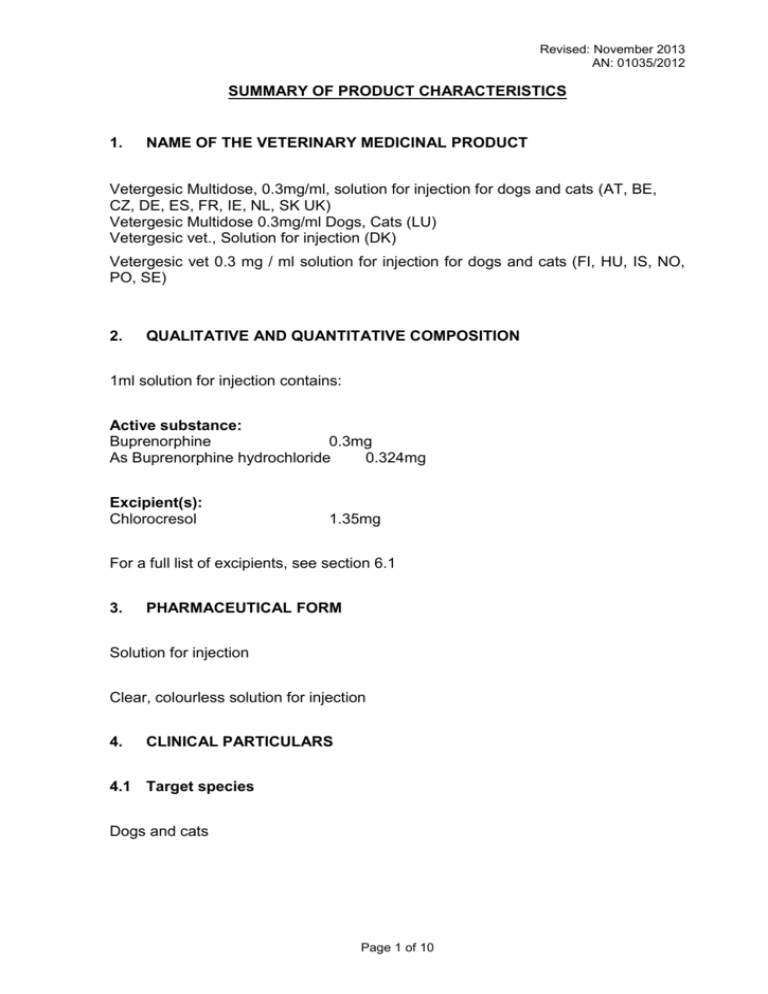
Revised: November 2013 AN: 01035/2012 SUMMARY OF PRODUCT CHARACTERISTICS 1. NAME OF THE VETERINARY MEDICINAL PRODUCT Vetergesic Multidose, 0.3mg/ml, solution for injection for dogs and cats (AT, BE, CZ, DE, ES, FR, IE, NL, SK UK) Vetergesic Multidose 0.3mg/ml Dogs, Cats (LU) Vetergesic vet., Solution for injection (DK) Vetergesic vet 0.3 mg / ml solution for injection for dogs and cats (FI, HU, IS, NO, PO, SE) 2. QUALITATIVE AND QUANTITATIVE COMPOSITION 1ml solution for injection contains: Active substance: Buprenorphine 0.3mg As Buprenorphine hydrochloride 0.324mg Excipient(s): Chlorocresol 1.35mg For a full list of excipients, see section 6.1 3. PHARMACEUTICAL FORM Solution for injection Clear, colourless solution for injection 4. CLINICAL PARTICULARS 4.1 Target species Dogs and cats Page 1 of 10 Revised: November 2013 AN: 01035/2012 4.2 Indications for use, specifying the target species DOG Post-operative analgesia. Potentiation of the sedative effects of centrally-acting agents. CAT Post-operative analgesia’ 4.3 Contraindications Do not administer by the intrathecal or peridural route. Do not use pre-operatively for Caesarian section (see Section 4.7). Do not use in animals with known hypersensitivity to the active substance or to any of the excipients 4.4 Special warnings None 4.5 Special precautions for use i) Special precautions for use in animals Buprenorphine may cause respiratory depression and as with other opioid drugs, care should be taken when treating animals with impaired respiratory function or animals that are receiving drugs that can cause respiratory depression. In case of renal, cardiac or hepatic dysfunction or shock, there may be greater risk associated with the use of the product. The benefit: risk assessment for using the product should be made by the attending vet. Safety has not been fully evaluated in clinically compromised cats. Buprenorphine should be used with caution in animals with impaired liver function, especially biliary tract disease, as the substance is metabolised by the liver and its intensity and duration of action may be affected in such animals. Page 2 of 10 Revised: November 2013 AN: 01035/2012 The safety of buprenorphine has not been demonstrated in animals less than 7 weeks of age, therefore, use in such animals should be based on the risk: benefit assessment of the veterinarian. Repeat administration earlier than the recommended repeat interval suggested in Section 4.9 is not recommended. Long-term safety of buprenorphine in cats has not been investigated beyond 5 consecutive days of administration. The effect of an opioid on head injury is dependent on the type and severity of the injury and the respiratory support supplied. The product should be used in accordance with the benefit:risk assessment of the attending veterinarian. ii) Special precautions to be taken by the person administering the veterinary medicinal product to animals Wash hands/affected area thoroughly after any accidental spillage. As buprenorphine has opioid-like activity, care should be taken to avoid selfinjection. In case of accidental self-injection or ingestion, seek medical advice immediately and show the package leaflet or the label to the physician. Following eye contamination or skin contact, wash thoroughly with cold running water. Seek medical advice if irritation persists. 4.6 Adverse reactions (frequency and seriousness) Salivation, bradycardia, hypothermia, agitation, dehydration and miosis can occur in the dog, and rarely hypertension and tachycardia. Mydriasis and signs of euphoria (excessive purring, pacing, rubbing) commonly occur in cats and will usually resolve within 24 hours. Buprenorphine may cause respiratory depression. (refer to section 4.5i) When used to provide analgesia, sedation is rarely seen, but may occur at dose levels higher than those recommended. Page 3 of 10 Revised: November 2013 AN: 01035/2012 Local discomfort or pain at the injection site, resulting in vocalisation, may occur very rarely*. The effect is normally temporary. * The frequency of possible adverse effects is defined using the following convention: Very common (affects more than 1 animal in 10) Common (affects 1 to 10 animals in 100) Uncommon (affects 1 to 10 animals in 1,000) Rare (affects 1 to 10 animals in 10,000) Very rare (affects less than 1 animal in 10,000) 4.7 Use during pregnancy, lactation or lay Pregnancy: Laboratory studies in rats have not produced any evidence of a teratogenic effect. However, these studies have shown post-implantation losses and early foetal deaths. These may have resulted from a reduction in parental body condition during gestation and in post-natal care owing to sedation of the mothers. As reproductive toxicity studies have not been conducted in the target species, use only according to the benefit/risk assessment by the responsible veterinarian. The product should not be used pre-operatively in cases of Caesarean section, due to the risk of respiratory depression in the offspring periparturiently, and should only be used post-operatively with special care (see below). Lactation: Studies in lactating rats have shown that, after intramuscular administration of buprenorphine, concentrations of unchanged buprenorphine in the milk equalled or exceeded that in the plasma. As it is likely that buprenorphine will be excreted in the milk of other species, use is not recommended during lactation. Use only according benefit: risk assessment by the responsible veterinarian. 4.8 Interaction with other medicinal products and other forms of interaction Buprenorphine may cause some drowsiness, which may be potentiated by other centrally acting agents, including tranquillisers, sedatives and hypnotics. Page 4 of 10 Revised: November 2013 AN: 01035/2012 There is evidence in humans to indicate that therapeutic doses of buprenorphine do not reduce the analgesic efficacy of standard doses of an opioid agonist, and that when buprenorphine is employed within the normal therapeutic range, standard doses of opioid agonist may be administered before the effects of the former have ended without compromising analgesia. However, it is recommended that buprenorphine is not used in conjunction with morphine or other opioid-type analgesics, e.g. etorphine, fentanyl, pethidine, methadone, papaveretum or butorphanol. Buprenorphine has been used with acepromazine, alphaxalone/alphadalone, atropine, dexmedetomidine, halothane, isoflurane, ketamine, medetomidine, propofol, sevoflurane, thiopentone and xylazine. When used in combination with sedatives, depressive effects on heart rate and respiration may be augmented. 4.9 Amounts to be administered and administration route Administration: Dog – intramuscular or intravenous injection Cat – intramuscular or intravenous injection Specie s 1.1.1 ROUTE OF 1.1.2 POST-OPERATIVE ANALGESIA 1.1.3 POTENTIATION OF SEDATION ADMINIST RATION Dog Intramuscular 10-20 micrograms per kg 10-20 micrograms per kg or intravenous (0.3-0.6ml per 10kg). (0.3-0.6ml per 10kg). injection For further pain relief, repeat if necessary after 34 hours with 10 microgram per kg or 5-6 hours with 20 microgram per kg. Cat Intramuscular 10 – 20 microgram per kg or intravenous (0.3 – 0.6ml per 10kg), injection repeated if necessary, once, after 1-2 hours. Page 5 of 10 --- Revised: November 2013 AN: 01035/2012 While sedative effects are present by 15 minutes after administration, analgesic activity becomes apparent after approximately 30 minutes. To ensure that analgesia is present during surgery and immediately on recovery, the product should be administered preoperatively as part of premedication. When administered for potentiation of sedation or as part of premedication, the dose of other centrally-acting agents, such as acepromazine or medetomidine, should be reduced. The reduction will depend on the degree of sedation required, the individual animal, the type of other agents included in premedication and how anaesthesia is to be induced and maintained. It may also be possible to reduce the amount of inhalational anaesthetic used. Animals administered opioids possessing sedative and analgesic properties may show variable responses. Therefore, the response of individual animals should be monitored and subsequent doses should be adjusted accordingly. In some cases, repeat doses may fail to provide additional analgesia. In these cases, consideration should be given to using a suitable injectable NSAID. An appropriately graduated syringe must be used to allow accurate dosing. 4.10 Overdose (symptoms, emergency procedures, antidotes), if necessary In cases of overdosage, supportive measures should be instituted, and, if appropriate, naloxone or respiratory stimulants may be used. When administered at overdose to dogs, buprenorphine may cause lethargy. At very high doses, bradycardia and miosis may be observed. Naloxone may be of benefit in reversing reduced respiratory rate and respiratory stimulants such as Doxapram are also effective in man. Because of the prolonged duration of effect of buprenorphine in comparison to such drugs, they may need to be administered repeatedly or by continuous infusion. Volunteer studies in man have indicated that opiate antagonists may not fully reverse the effects of buprenorphine. In toxicological studies of buprenorphine hydrochloride in dogs, biliary hyperplasia was observed after oral administration for one year at dose levels of 3.5mg/kg/day and above. Biliary hyperplasia was not observed following daily intramuscular injection of dose levels up to 2.5mg/kg/day for 3 months. This is well in excess of any clinical dose regimen in the dog. Please also refer to Sections 4.5 and 4.6 of this SPC. Page 6 of 10 Revised: November 2013 AN: 01035/2012 4.11 Withdrawal period(s) Not applicable. 5. PHARMACOLOGICAL IMMUNOLOGICAL PROPERTIES Pharmacotherapeutic group: analgesics, opioids, oripavine derivatives ATC Vetcode: QN02AE01. 5.1 Pharmacodynamic properties In summary, buprenorphine is a potent, long-acting analgesic acting at opiate receptors in the central nervous system. Buprenorphine can potentiate the effects of other centrally-acting agents, but unlike most opiates, buprenorphine has, at clinical doses, only a limited sedative effect of its own. Buprenorphine exerts its analgesic effect via high affinity binding to various subclasses of opiate receptors, particularly µ, in the central nervous system. At clinical dose levels for analgesia, buprenorphine binds to opiate receptors with high affinity and high receptor avidity, such that its dissociation from the receptor site is slow, as demonstrated in in vitro studies. This unique property of buprenorphine could account for its longer duration of activity when compared to morphine. In circumstances where excessive opiate agonist is already bound to opiate receptors, buprenorphine can exert a narcotic antagonistic activity as a consequence of its high-affinity opiate receptor binding, such that an antagonistic effect on morphine equivalent to naloxone has been demonstrated. Buprenorphine has little effect on gastro-intestinal motility. 5.2 Pharmacokinetic particulars When given parenterally, the product may be administered by intramuscular or intravenous injection. Buprenorphine is rapidly absorbed after intramuscular injection in various animal species and man. The substance is highly lipophilic and the volume of distribution in body compartments is large. Pharmacological effects (e.g. mydriasis) may occur within minutes of administration and signs of sedation normally appear by 15 minutes. Analgesic effects appear around 30 minutes with peak effects usually being observed at about 1 – 1.5 hours. Page 7 of 10 Revised: November 2013 AN: 01035/2012 Following intravenous administration to dogs at a 20μg/kg dose, the mean terminal half-life was 9 hours and the mean clearance was 24 ml/kg/min, however, there is considerable inter-dog variability in pharmacokinetic parameters. Following intramuscular administration to cats, the mean terminal half-life was 6.3 hours and the clearance was 23 mL/kg/min; however, there was considerable intercat variability in pharmacokinetic parameters. Combined pharmacokinetic and pharmacodynamic studies have demonstrated a marked hysteresis between plasma concentration and analgesic effect. Plasma concentrations of buprenorphine should not be used to formulate individual animal dosage regimens, which should be determined by monitoring the patient’s response. The major route of excretion in all species except the rabbit (where urinary excretion predominates) is the faeces. Buprenorphine undergoes N-dealkylation and glucuronide conjugation by the intestinal wall and the liver and its metabolites are excreted via the bile into the gastro-intestinal tract. In tissue distribution studies carried out in rats and rhesus monkeys the highest concentrations of drug-related material were observed in liver, lung and brain. Peak levels occurred rapidly and declined to low levels by 24 hours after dosing. Protein binding studies in rats have shown that buprenorphine is highly bound to plasma proteins, principally to alpha and beta globulins. 6. PHARMACEUTICAL PARTICULARS 6.1 List of excipients Chlorocresol, Glucose anhydrous, Hydrochloric acid, Water for injection. Page 8 of 10 Revised: November 2013 AN: 01035/2012 6.2 Incompatibilities In the absence of compatibility studies, this veterinary medicinal product must not be mixed with other veterinary medicinal products. 6.3 Shelf life Shelf-life of the veterinary medicinal product as packaged for sale: 2 years Shelf-life after first opening the immediate packaging: 28 days 6.4. Special precautions for storage Do not store above 25ºC. Keep the vial in the outer carton in order to protect from light. Shake well before use. 6.5 Nature and composition of immediate packaging Presented in a 10ml amber, Type I glass vial with chlorobutyl rubber stopper and a 20 mm aluminium collar with a flip-off cap. 6.6 Special precautions for the disposal of unused veterinary medicinal product or waste materials derived from the use of such products Any unused veterinary medicinal product or waste materials derived from such veterinary medicinal products should be disposed of in accordance with local requirements. 7. MARKETING AUTHORISATION HOLDER Alstoe Limited The Industrial Park Sheriff Hutton York YO60 6RZ Page 9 of 10 Revised: November 2013 AN: 01035/2012 8. MARKETING AUTHORISATION NUMBER Vm 14094/4004 9. DATE OF FIRST AUTHORISATION Date: 11/04/2008 10. DATE OF REVISION OF THE TEXT Date: November 2013 APPROVED Page 10 of 10 28/11/2013
